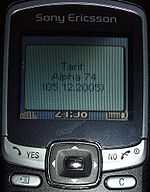Unstructured Supplementary Service Data

Unstructured Supplementary Service Data (USSD) is a protocol used by GSM cellular telephones to communicate with the service provider's computers. USSD can be used for WAP browsing, prepaid callback service, mobile-money services, location-based content services, menu-based information services, and as part of configuring the phone on the network.[1]
USSD messages are up to 182 alphanumeric characters in length. Unlike Short Message Service (SMS) messages, USSD messages create a real-time connection during a USSD session. The connection remains open, allowing a two-way exchange of a sequence of data. This makes USSD more responsive than services that use SMS.[1]
Uses
When a user sends a message to the phone company network, it is received by a computer dedicated to USSD. The computer's response is sent back to the phone, generally in a basic format that can easily be seen on the phone display. Messages sent over USSD are not defined by any standardization body, so each network operator can implement whatever is most suitable for its customers.
USSD can be used to provide independent calling services such as a callback service (to reduce phone charges while roaming), enhance mobile marketing capabilities or interactive data services.
USSD is commonly used by prepaid GSM cellular phones to query the available balance. The vendor's "check balance" application hides the details of the USSD protocol from the user. On some pay as you go networks, such as Tesco Mobile, once a user performs an action that costs money, the user sees a USSD message with his new balance. USSD can also be used to refill the balance on the user's SIM card and to deliver one time passwords or PIN codes.
Some operators use USSD to provide access to real-time updates from social-networking websites like Facebook and Twitter.[2] Wikipedia uses USSD to send articles to some feature phones.[3]
USSD is sometimes used in conjunction with SMS. The user sends a request to the network via USSD, and the network replies with an acknowledgement of receipt:
- "Thank you, your message is being processed. A message will be sent to your phone."
Subsequently, one or more mobile terminated SMS messages communicate the status and/or results of the initial request.[4] In such cases, SMS is used to "push" a reply or updates to the handset when the network is ready to send them.[5] In contrast, USSD is used for command-and-control only.
Technical details
Most GSM phones have USSD capability.[6] USSD is generally associated with real-time or instant messaging services. There is no store-and-forward capability, as is typical of other short-message protocols like SMS. In other words, an SMSC is not present in the processing path.
USSD Phase 1, as specified in GSM 02.90, only supports mobile-initiated ("pull") operations.[7] In the core network, the message is delivered over MAP, USSD Phase 2, as specified in GSM 03.90.[8] After entering a USSD code on a GSM handset, the reply from the GSM operator is displayed within a few seconds.
Format
A typical USSD message starts with an asterisk (*) followed by digits that comprise commands or data. Groups of digits may be separated by additional asterisks. The message is terminated with a number sign (#).[1]
USSD Mode
Mobile-initiated
- USSD/ PULL or USSD/ P2P
- when the user dials a code, e.g. *139# from a GSM mobile handset
Network-initiated
- USSD/ PUSH or USSD/A2P
- when the user receives a push message from the network; primarily used for promotional services
| Example USSD codes |
|---|
| *101# |
| *139*1*1234567890# |
See also
- USSD Gateway
- Ultra Mobile Broadband
- USSD Technology and Packet Flow (Facebook page)
- Supplementary service codes
References
- ↑ 1.0 1.1 1.2 "Unstructured Supplementary Services Data (USSD)". TelecomSpace. Retrieved August 23, 2010.
- ↑ Shetty, Anuradha (16 July 2011). "TATA Docomo introduces Facebook, Twitter access via USSD". Tech2. Network 18 India. Retrieved 9 May 2013.
- ↑ Wadhwa, Kul (22 February 2013). "Getting Wikipedia to the people who need it most". Wikimedia blog. Wikimedia Foundation. Retrieved 10 May 2013.
- ↑ "Monitor usage on your phone". AT&T Residential Wireless Support. Retrieved 14 May 2012.
- ↑ "Manage your account". AT&T Residential Wireless Support. AT&T. Retrieved 11 May 2013.
- ↑ "Windows Phone 7 doesn't support USSD". Microsoft Answers. Microsoft. 8 February 2012. Retrieved 11 May 2013.
- ↑ "GSM 02.90 (ETSI TS 100 625, V7.0.0) Specification (USSD) – Stage 1". 3gpp.org. 3rd Generation Partnership Project. Retrieved 11 May 2013.
- ↑ "GSM 03.90 (ETSI TS 100 549, V7.0.0) Specification (USSD) – Stage 2". 3gpp.org. 3rd Generation Partnership Project. Retrieved 11 May 2013.
External links
- GSM 04.90 (ETSI EN 300 957, V7.0.1) Specification (USSD) Stage 3 – 3GPP